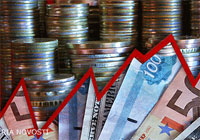Russian economic growth rate to be not over 3%-3.5% in 2013 – Citi

MOSCOW. Feb 7 (Interfax) – The rate of Russian economic growth this year will not be any more than 3%-3.5%, Citi economist for Russia and Commonwealth of Independent States countries Natalya Novikova thinks.
Novikova told the press on Thursday that Citi analysts are not expecting a significant decline in the price of oil this year, but the problem for the Russian economy is that its growth rate is slowing in the absence of oil price growth.
Stable or slumping oil prices have a positive effect on inflation, Novikova said, which in 2013 is also under the influence of a drop in economic growth and consumer demand. It will be around 6%, she said.
In the first half of this year, the ruble exchange rate – against a backdrop of relatively high oil prices and a fairly low level of ruble liquidity – will increase a little, but in H2 the Russian currency is likely to face a small decrease amid sliding oil prices, Novikova said. Primary commodity analysts at Citi forecast that by the end of this year oil will be down to $95 per barrel.
On the other hand, Citi analyst for the oil and gas sector Ronald Smith said at the press conference that, generally speaking, no-one can say with confidence what level oil and gas quotations will be on in the coming twelve months.
Oil prices are especially hard to predict, as they are influenced by a great many factors, Smith said. Long-term forecasts can be said to be more reliable. Smith said he expects that in the long-term perspective pressure on oil quotations will be observed, including due to the development of shale oil production. However, it is worth noting that the production of shale oil is differs by a significant decline – somewhere around 80% – in volumes after the first year of a well’s use, so to support shale oil production volume new wells need to be drilled, not 10, not 100, but 1000 new wells, Smith said. That is why he does not think that prices for oil in the long-term perspective are likely to be at the $100/barrel level (not counting inflation), he said, although they are unlikely to go under $70-$80, since at those levels there will be a tangible drop in the production of shale oil.
Citi strategists for Russia Kingsmill Bond and Andrei Kuznetsov reckon that in the current situation the securities most attractive for investment are stock in companies oriented to the domestic market, since they more than others win when consumer demand goes up. Furthermore, the investment attractiveness of the Russian oil and gas sector could rise, if the government decides to make changes to the tax regime for the sector with the aim of stimulating the growth of production.
“At the present time, growth in production volume is not built into market evaluations of Russian oil and gas sector stocks, so the potential for them to rise positively will have a positive influence on the evaluation of this segment,” Kuznetsov said.
